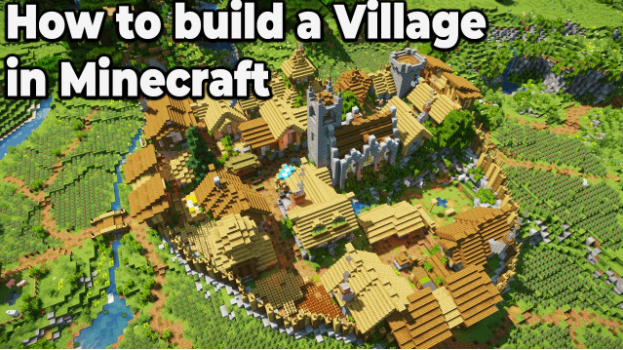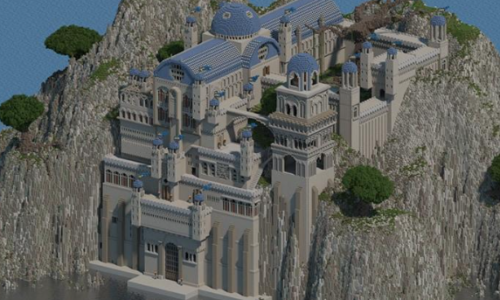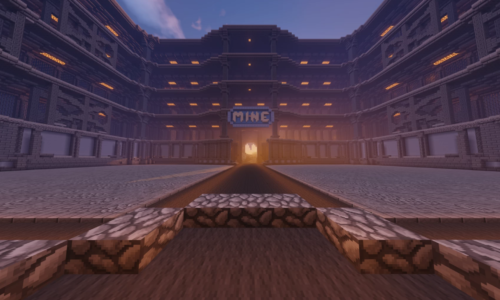Are you tired of wandering around in Minecraft’s vast world, searching for a place to call home? Building a village from scratch can be a daunting task, but with the right tools and strategies, you can create a thriving community that will become the envy of your friends.
In this guide, we’ll take you through the step-by-step process of building a Minecraft village, from selecting the perfect location to attracting new residents and keeping them happy. Whether you’re a seasoned Minecraft player or just starting out, this guide will equip you with the knowledge and skills you need to create a bustling community that will stand the test of time. So grab your pickaxe, gather your resources, and let’s get started!
How to Build a Minecraft Village and Create a Thriving Community
Choose a location for your village and gather resources.
Build houses for your villagers and create a farm for food.
Create paths and roads to connect the different parts of your village.
Trade with villagers and protect them from monsters.
Expand your village by adding new buildings and attracting more villagers.
How to Build a Minecraft Village and Create a Thriving Community
Minecraft is a popular sandbox video game that enables players to build, explore, and create their virtual world. One of the most exciting aspects of the game is building villages and communities that come to life. Minecraft villages are a great way to show off your creativity and engage with other players. In this article, we will discuss how to build a Minecraft village and create a thriving community.
1. Selecting the Right Biome
The first step to building a Minecraft village is to select the right biome. A biome is a region in Minecraft with distinct environmental features such as temperature, precipitation, vegetation, and wildlife. Each biome has unique resources, terrain, and challenges that can affect your village’s growth and development.
For instance, if you want to build a village with a lot of crops, you might choose a plains biome with flat terrain and plenty of water sources. If you prefer a more exotic setting, you could opt for a jungle biome with towering trees and abundant wildlife. Once you have chosen your biome, it’s time to start building.
Benefits:
– Choosing the right biome can help you get the resources you need for your village.
– It can help you create a more immersive and enjoyable gaming experience.
VS:
– Choosing the wrong biome can make it harder to get the resources you need.
– It can lead to a frustrating and less engaging gaming experience.
2. Planning Your Village Layout
The next step is to plan your village layout. A well-designed village can make it easier for your villagers to navigate and interact with each other. You can create different zones for farming, housing, trading, and other activities.
Start by laying out the main paths and roads that will connect different parts of your village. Then, you can add buildings, farms, and other structures along the way. Try to create a central square or plaza where villagers can gather, trade, and socialize.
Benefits:
– Planning your village layout can help you create a more organized and functional community.
– It can make it easier for your villagers to find their way around and interact with each other.
VS:
– Poor village planning can lead to confusion and frustration for your villagers.
– It can make it harder for you to manage and grow your community.
3. Building Your First House
Once you have planned your village layout, it’s time to start building your first house. You can use different materials such as wood, stone, or cobblestone to create a unique and personalized house. Make sure to include all the essential features such as doors, windows, and a roof.
You can also add decorative elements such as flower pots, paintings, and furniture to make your house more welcoming and cozy. Don’t forget to light up your house with torches or lamps to protect yourself from monsters at night.
Benefits:
– Building your first house can give you a sense of accomplishment and progress.
– It can inspire you to keep building and expanding your village.
VS:
– Poorly built houses can be vulnerable to attacks from monsters and other players.
– It can make your village less attractive and less enjoyable.
4. Creating Farms and Gardens
Farms and gardens are essential for your village’s survival and growth. You can create different types of farms such as wheat, carrots, potatoes, and beetroot to feed your villagers. You can also create gardens with flowers, shrubs, and trees to beautify your village and create a more pleasant atmosphere.
Try to automate your farms using hoppers, dispensers, and other redstone devices to save time and effort. You can also use different types of fertilizers such as bone meal or compost to increase your crop yield.
Benefits:
– Creating farms and gardens can provide your villagers with food and resources.
– It can make your village more attractive and enjoyable to live in.
VS:
– Neglecting your farms and gardens can lead to food shortages and unhappy villagers.
– It can make your village less productive and less prosperous.
5. Building a Trading Center
Trading is an essential part of Minecraft village life. You can trade different resources such as crops, tools, and weapons with other players and villagers. To make trading more efficient and convenient, you can build a trading center or marketplace where villagers can buy and sell goods.
You can use different blocks such as emerald blocks, barrels, and lecterns to create a trading center. You can also assign specific professions to your villagers such as farmers, fishermen, or librarians to increase their trading options.
Benefits:
– Building a trading center can provide your villagers with more trading options and opportunities.
– It can make your village more prosperous and self-sufficient.
VS:
– Neglecting trading can limit your access to valuable resources and items.
– It can make your village less competitive and less advanced.
6. Defending Your Village
Defending your village is crucial to your survival and growth in Minecraft. You will face different types of threats such as monsters, raiders, and griefers that can harm your village and its inhabitants.
To defend your village, you can use different strategies such as building walls, traps, and watchtowers. You can also equip yourself and your villagers with weapons such as swords, bows, and shields to fight off attackers.
Benefits:
– Defending your village can protect your villagers and their property from harm.
– It can make your village more secure and resilient.
VS:
– Neglecting defense can lead to frequent attacks and the destruction of your village.
– It can make your village less safe and less enjoyable.
7. Expanding Your Village
Once you have established your village and made it self-sufficient, it’s time to expand your horizons. You can explore different areas of your biome and beyond to find new resources, settlements, and adventures.
You can also invite other players to join your village or visit other villages to exchange ideas and resources. You can create alliances, trade routes, and diplomatic relations with other villages to create a more vibrant and dynamic community.
Benefits:
– Expanding your village can provide you with new resources, opportunities, and challenges.
– It can make your village more diverse and interesting.
VS:
– Neglecting expansion can limit your growth and potential.
– It can make your village less relevant and less competitive.
8. Hosting Events and Festivals
Hosting events and festivals is a great way to engage with your villagers and other players. You can create different types of events such as concerts, sports, contests, and holidays to celebrate your village’s achievements and culture.
You can use different blocks such as banners, fireworks, and music boxes to create a festive atmosphere. You can also create different types of games and challenges to entertain your guests and reward them with prizes.
Benefits:
– Hosting events and festivals can promote community spirit and creativity.
– It can make your village more popular and attractive.
VS:
– Neglecting events and festivals can lead to a lack of community engagement and enthusiasm.
– It can make your village less inspiring and less social.
9. Sharing Your Village with Others
Sharing your village with others is one of the most rewarding aspects of Minecraft. You can showcase your creativity, skill, and personality to other players and inspire them to build their own villages and communities.
You can share your village with others by creating videos, screenshots, or tours that highlight its features and history. You can also join different Minecraft communities and forums to connect with other players and share your experiences.
Benefits:
– Sharing your village with others can give you a sense of pride and recognition.
– It can make your village more influential and inspiring.
VS:
– Neglecting to share can limit your exposure and impact.
– It can make your village less visible and less valued.
10. Maintaining Your Village
Maintaining your village is an ongoing process that requires attention, care, and dedication. You will face different types of challenges such as resource depletion, population growth, and environmental changes that can affect your village’s stability and prosperity.
To maintain your village, you can use different strategies such as resource management, population control, and environmental protection. You can also seek help and advice from other players and villagers to overcome your challenges and achieve your goals.
Benefits:
– Maintaining your village can ensure its long-term survival and growth.
– It can make your village more resilient and adaptable.
VS:
– Neglecting maintenance can lead to stagnation and decline.
– It can make your village less appealing and less functional.
In conclusion, building a Minecraft village and creating a thriving community is a fun and rewarding experience that requires creativity, planning, and teamwork. By following these tips and strategies, you can create a village that reflects your personality, values, and aspirations and inspires others to do the same.
Frequently Asked Questions
Q: How do I start building a Minecraft village?
To start building a Minecraft village, you need to first choose a suitable location. Look for an area with flat terrain and plenty of resources. Once you have found the ideal location, you can start by creating the basic infrastructure of the village. This includes building houses, farms, and other essential structures. You can also add decorative elements like roads, bridges, and parks to make the village more attractive.
To make the village thrive, you need to attract villagers. You can do this by building doors, beds, and workstations. Villagers will only spawn if the village meets certain requirements, such as having enough beds and workstations. Once you have enough villagers, you can start trading with them to acquire valuable resources and items.
Q: How do I protect my Minecraft village from mobs?
Mobs can be a major threat to your Minecraft village, so it is important to take measures to protect it. One of the most effective ways to do this is to build a wall or fence around the perimeter of the village. This will prevent hostile mobs from entering and attacking the villagers. You can also install lighting around the village to prevent mobs from spawning in the first place.
Another way to protect your village is to equip the villagers with weapons and armor. You can trade with them to acquire these items or craft them yourself using resources like iron and diamonds. Finally, you can also build iron golems to defend the village. These powerful creatures will attack any mobs that threaten the villagers.
Q: How do I expand my Minecraft village?
To expand your Minecraft village, you need to continue building new structures and attracting new villagers. You can create new houses, farms, and other buildings as needed to accommodate more villagers. You can also trade with the villagers to acquire more resources and items, which will allow you to continue expanding the village.
It is also important to make sure that the village meets the requirements for villager breeding. This includes having enough beds and workstations, as well as a surplus of food. With enough villagers, you can start a breeding program to create a sustainable population that will continue to grow and thrive.
Q: How do I make my Minecraft village more efficient?
To make your Minecraft village more efficient, you need to optimize the layout and design of the village. This includes creating a central hub with easy access to all important structures, like farms and trading halls. You should also create efficient transportation systems, such as minecart tracks or waterways, to make it easier to move around the village.
Another way to improve efficiency is to automate certain tasks. For example, you can create automatic farms using redstone mechanisms to harvest crops and collect resources. You can also create auto-sorting systems to organize items and keep the village tidy.
Q: How do I create a sense of community in my Minecraft village?
To create a sense of community in your Minecraft village, you need to foster relationships between the villagers. You can do this by creating communal areas, such as parks or community centers, where the villagers can gather and socialize. You can also create events and festivals to bring the villagers together and celebrate important holidays.
It is also important to give the villagers jobs and roles within the community. This will give them a sense of purpose and help them feel like they are contributing to the village’s success. Finally, you can create a sense of history and tradition by creating landmarks and monuments that commemorate important events or achievements in the village’s history.
7 EASY Steps To Improve A Minecraft Village!
In conclusion, creating a thriving Minecraft village requires patience, creativity, and dedication. Building a strong foundation with the right materials and design is vital to attract new villagers and keep them happy. But it’s not just about constructing buildings; it’s also about creating a sense of community and providing resources for everyone to thrive.
One key aspect of building a successful village is to establish a reliable food source. Farming crops and raising animals like cows and pigs can provide a steady supply of food for your villagers. Additionally, creating communal spaces like a town hall or market can foster a sense of community and encourage trade.
It’s important to remember that building a Minecraft village is not a one-time task. It requires ongoing maintenance and upkeep to keep the community thriving. Whether it’s expanding the village, adding new buildings, or improving existing infrastructure, there’s always something to do to keep the village growing and evolving.
In the end, building a Minecraft village is a fun and rewarding experience that allows you to flex your creative muscles and build something truly unique. With the right mindset and approach, you can create a thriving community that your villagers will love calling home.




